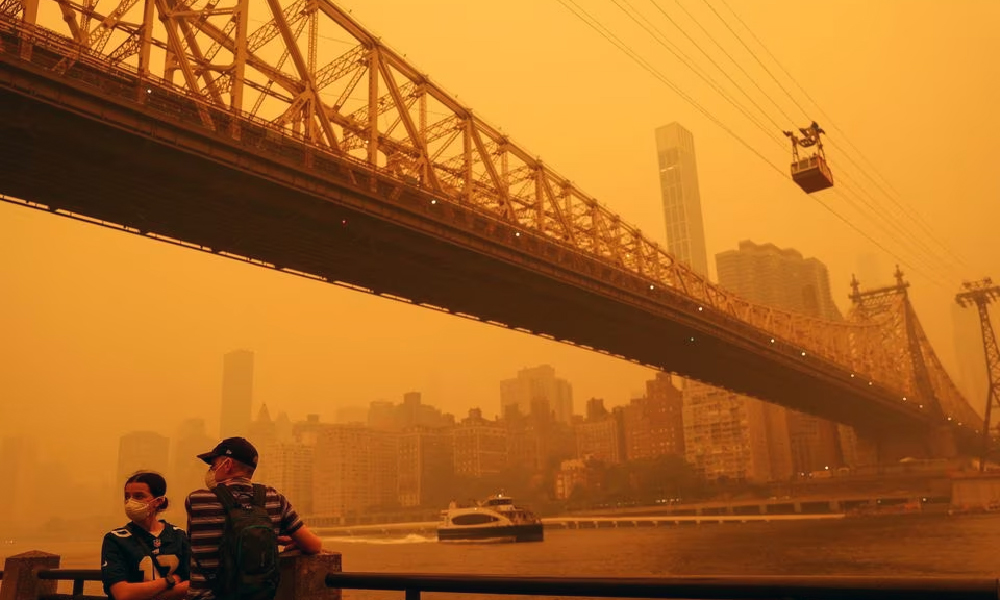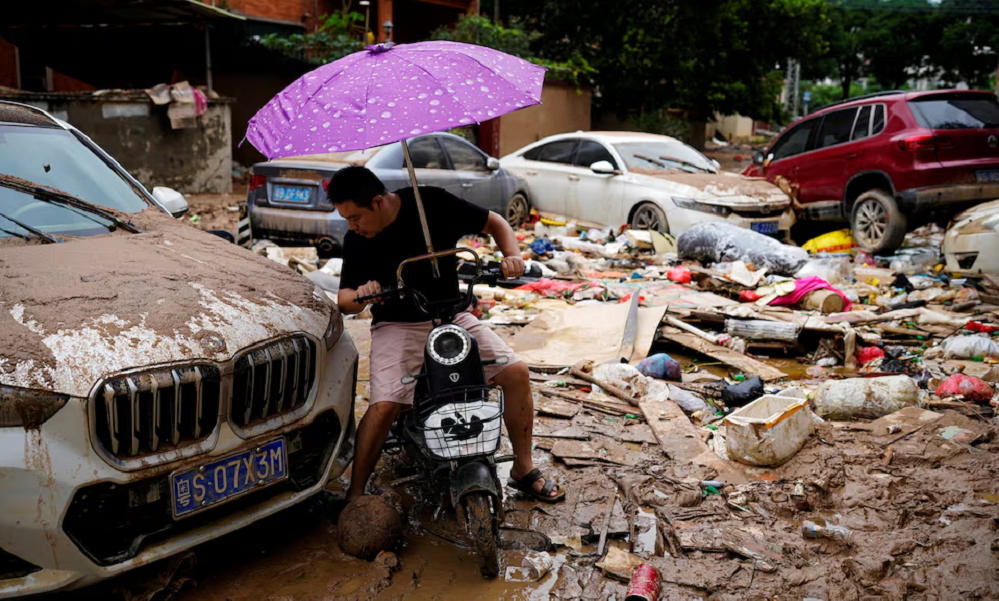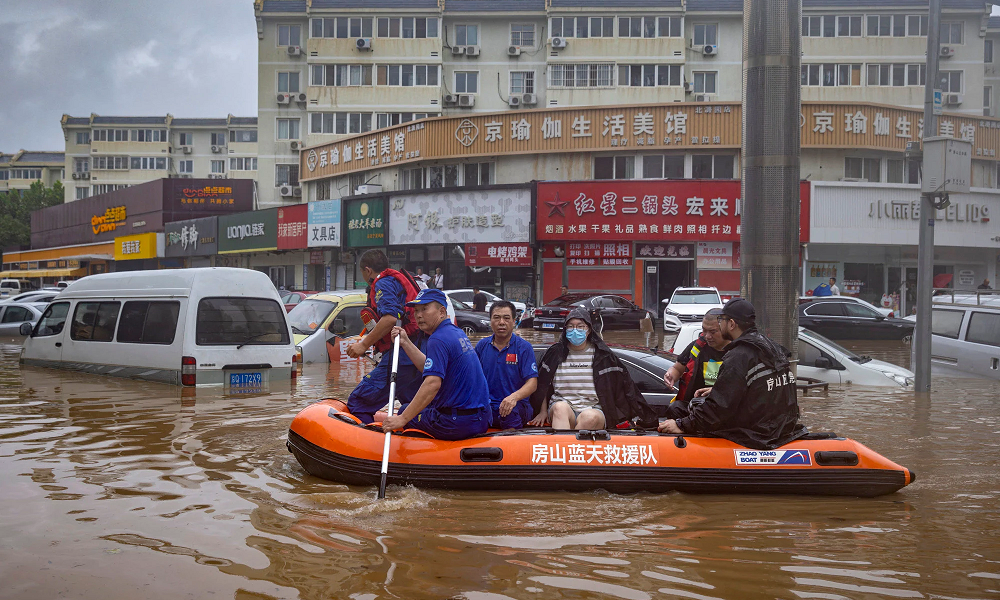Climate Change
US East Coast blanketed in veil of smoke from Canadian fires

Schools across the U.S. East Coast canceled outdoor activities, airline traffic slowed and millions of Americans were urged to stay indoors on Wednesday as smoke from Canadian wildfires drifted south, blanketing cities in thick, yellow haze.
The U.S. National Weather Service issued air quality alerts for virtually the entire Atlantic seaboard. Health officials from Vermont to South Carolina and as far west as Ohio and Kansas warned residents that spending time outdoors could cause respiratory problems due to high levels of fine particulates in the atmosphere, Reuters reported.
“It’s critical that Americans experiencing dangerous air pollution, especially those with health conditions, listen to local authorities to protect themselves and their families,” President Joe Biden said on Twitter.
U.S. private forecasting service AccuWeather said thick haze and soot extending from high elevations to ground level marked the worst outbreak of wildfire smoke to blanket the Northeastern U.S. in more than 20 years.
New York’s famous skyline, usually visible for miles, appeared to vanish in an otherworldly veil of smoke, which some residents said made them feel unwell.
“It makes breathing difficult,” Mohammed Abass said as he walked down Broadway in Manhattan. “I’ve been scheduled for a road test for driving, for my driving license today, and it was canceled.”
The smoky air was especially tough on people toiling outdoors, such as Chris Ricciardi, owner of Neighbor’s Envy Landscaping in Roxbury, New Jersey. He said he and his crew were curtailing work hours and wearing masks they used for heavy pollen.
“We don’t have the luxury to stop working,” he said. “We want to keep our exposure to the smoke to a minimum, but what can you really do about it?”
Angel Emmanuel Ramirez, 29, a fashion stylist at a Givenchy outlet in Manhattan, said he and fellow workers began feeling ill and closed up shop early when they realized the smell of smoke was permeating the store.
“It’s so intense, you would think the wildfire was happening right across the river, not up in Canada,” Ramirez said.
New York Governor Kathy Hochul called the situation an “emergency crisis,” saying the air pollution index for parts of her state were eight times above normal.
Reduced visibility from the haze forced the Federal Aviation Administration to slow air traffic into the New York City area and Philadelphia from elsewhere on the East Coast and upper Midwest, with flight delays averaging about a half hour, Reuters reported.
In some areas, the air quality index (AQI), which measures major pollutants including particulate matter produced by fires, was well above 400, according to Airnow, which sets 100 as “unhealthy” and 300 as “hazardous.”
SMOKE CROSSING FROM CANADA
The smoke billowed over the U.S. border from Canada, where hundreds of forest fires have scorched 9.4 million acres (3.8 million hectares) and forced 120,000 people from their homes in an unusually early and intense start to the wildfire season.
Poor air quality is likely to persist into the weekend, with a developing storm system expected to shift the smoke westward across the Great Lakes and deeper south through the Ohio Valley and into the mid-Atlantic region, AccuWeather said.
Climate Change
Rescuers race to reach those trapped by floods in China’s Guangdong

WATCH: Rescuers on boats in China’s flood-ravaged Guangdong province raced to evacuate trapped residents, carrying some elderly people by piggyback from their homes and deploying helicopters to save villagers caught in rural landslides.
The southern Chinese province has been battered by unusually heavy, sustained and widespread rainfall since Thursday, with powerful storms ushering in an earlier-than-normal start to the region’s annual flooding season, Reuters reported.
Eleven people were missing in Guangdong by Monday morning, the state-owned Xinhua News Agency reported without giving further details.
Across the province, 53,741 people have been relocated, with 12,256 people being urgently resettled, Xinhua reported, citing the provincial government.
The cities of Shaoguan, Qingyuan, Zhaoqing and Jiangmen to the west and north of the provincial capital Guangzhou have been particularly hard hit.
In Qingyuan, houses and shops along the Bei River were submerged as the Pearl River tributary swelled, local media reported.
Aerial footage showed flood waters overwhelming a nearby town, leaving only roofs and treetops untouched.
Rescuers in Qingyuan tackled muddy waters, neck-high in some areas, to extract residents, including an elderly lady trapped in waist-deep water in an apartment building, videos on social media showed.
Other social media videos showed water gushing through roads and vehicles in disarray.
In Shaoguan, landslides trapped villagers who had to be rescued by helicopter while other rescuers traveled on foot to reach cut-off disaster sites, Reuters reported.
The Chinese military also stepped in to help clear roads.
The rains eased early on Monday, but some schools in the province were suspended.
Powerful thunderstorms are expected to return later in the week after a brief respite, marking an unusually early wet spell that is more typical in the months of May and June.
Climate Change
Massive river flooding expected in China, threatening millions

Major rivers, waterways and reservoirs in China’s Guangdong province are threatening to unleash dangerous floods, forcing the government on Sunday to enact emergency response plans to protect more than 127 million people.
Calling the situation “grim”, local weather officials said sections of rivers and tributaries at the Xijiang and Beijiang river basins are hitting water levels in a rare spike that only has a one-in-50 chance of happening in any given year, state broadcaster CCTV news said on Sunday.
China’s water resource ministry issued an emergency advisory, CCTV reported.
Guangdong officials urged departments in all localities and municipalities to begin emergency planning to avert natural disasters and promptly disperse disaster relief funds and materials to ensure affected people have food, clothing, water and a place to live, Reuters reported.
The province, a major exporter and one of China’s main commercial and trading centers, has seen torrid downpours for several days and strong winds due to severe convective weather, which has also affected other parts of China.
A 12-hour stretch of heavy rain, starting from 8 p.m. (1200 GMT) Saturday, battered the central and northern parts of the province in the cities of Zhaoqing, Shaoguan, Qingyuan and Jiangmen.
Almost 20,000 people have been evacuated in Qingyuan, according to state media, and some power facilities in Zhaoqing were damaged, cutting power to some places, Reuters reported.
Climate Change
UN sounds ‘Red Alert’ as world smashes heat records in 2023

Every major global climate record was broken last year and 2024 could be worse, the World Meteorological Organization (WMO) said on Tuesday, with its chief voicing particular concern about ocean heat and shrinking sea ice, Reuters reported.
The U.N. weather agency said in its annual State of the Global Climate report that average temperatures hit the highest level in 174 years of record-keeping by a clear margin, reaching 1.45 degrees Celsius above pre-industrial levels.
Ocean temperatures also reached the warmest in 65 years of data with over 90% of the seas having experienced heatwave conditions during the year, the WMO said, harming food systems.
“The WMO community is sounding the Red Alert to the world,” said WMO Secretary-General Celeste Saulo, who took over the job in January.
“What we witnessed in 2023, especially with the unprecedented ocean warmth, glacier retreat and Antarctic sea ice loss, is cause for particular concern.”
She later told reporters that ocean heat was particularly concerning because it was “almost irreversible”, possibly taking millennia to reverse.
“The trend is really very worrying and that is because of the characteristics of water that keep heat content for longer than the atmosphere,” she said.
Climate change, driven by the burning of fossil fuels, coupled with the emergence of the natural El Nino climate pattern, pushed the world into record territory in 2023, read the report.
WMO’s head of climate monitoring, Omar Baddour, told reporters there was a “high probability” that 2024 would set new heat records, saying that the year after an El Nino was typically warmer still.
Tuesday’s report showed a big plunge in Antarctic sea ice, with the peak level measured at 1 million km2 below the previous record – an area roughly equivalent to the size of Egypt.
That trend, combined with ocean warming which causes water to expand, has contributed to a more than doubling of the rate of sea-level rise over the past decade compared with the 1993-2002 period, it said.
Ocean heat was concentrated in the North Atlantic with temperatures an average 3 degrees Celsius above average in late 2023, the report said. Warmer ocean temperatures affect delicate marine ecosystems and many fish species have fled north from this area seeking cooler temperatures, Reuters reported.
Saulo, a meteorologist from Argentina who has promised to strengthen global warning systems for climate disasters, said she hoped the report would raise awareness of the “vital need to scale up the urgency and ambition of climate action”.
“That’s why we spoke about the Red Alert because we must care for the people and how they will suffer from these more frequent, more extreme events,” she told reporters. “If we do nothing, things will become worse and that will be our responsibility.”
-

 Sport4 days ago
Sport4 days agoAfghanistan beat Iraq 5-3, inch closer to Futsal World Cup berth
-

 Regional4 days ago
Regional4 days agoNew UK sanctions target Iranian drone industry
-

 Latest News4 days ago
Latest News4 days agoEU allocates 17 million euros to support Afghans on the move
-

 Latest News3 days ago
Latest News3 days agoPakistan extends registered Afghan refugees’ stay till June 30
-

 World5 days ago
World5 days agoUS student protests over Gaza intensify despite arrests
-

 Regional3 days ago
Regional3 days agoChina to host Hamas, Fatah for Palestinian unity talks
-

 Sport2 days ago
Sport2 days agoAfghanistan qualify for FIFA Futsal World Cup for first time ever
-

 Sport5 days ago
Sport5 days agoIndia’s Pant boosts World Cup hopes with IPL batting blitz















